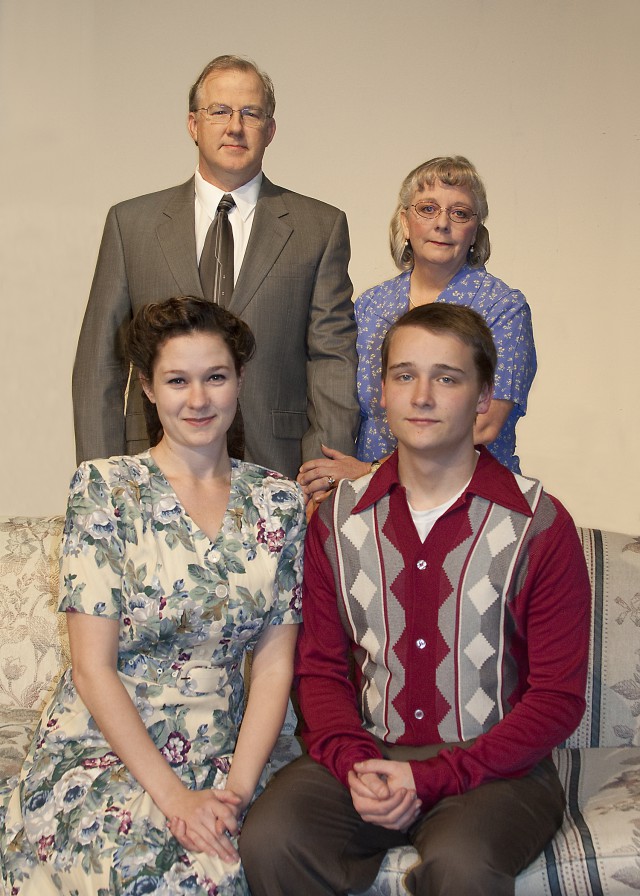
Imagine if, by some twist of fate, Brad Pitt accepted an invitation to dinner at your home some wintry evening. Further imagine that as Mr. Pitt was reaching for your doorbell he slipped on a patch of ice and broke his hip.
Then, just for fun, imagine that the doctor — who in this fantasy world actually made a house call — diagnosed Brad’s condition as too delicate for travel and confined him to your home for at least a two-week convalescence.
Now replace Brad Pitt with a Rush Limbaugh fresh out of Oxycontin, and you have some idea of the horror that befalls the Stanley family in The Man Who Came to Dinner.
Originally produced in 1939 and since adapted for radio, television and the big screen, The Man Who Came to Dinner has proven itself deserving of the label “classic.” Yet, until now, I have never seen it live on stage, so I want to give a great, big “Thank you!” to the Longmont Theatre Company for bringing George S. Kaufman and Moss Hart’s comic crucible to Boulder County. LTC does the play justice and delivers an affable, traditional take on the material.
Set in small-town Ohio in the weeks leading up to Christmas 1939, The Man Who Came to Dinner gives us one of the earliest male divas in radio show host and acid-tongued commentator on any and everything, Sheridan Whiteside (Byron Thompson). Incredibly intelligent, insightful and witty, Whiteside is also a tyrant of Nero-ian proportions. After his unfortunate slip-and-fall, he not only takes over his hosts’ home, he jovially informs them that he will be suing them for an exorbitant amount of damages as well.
Whiteside’s increasingly unwilling hosts are the Stanley family. Father Ernest ( Jim Porter) is a successful businessman whose patience with Mr. Whiteside’s ever-more-onerous intrusion quickly dwindles. Wife and mother Daisy (Elaine Niesen) comports herself as a paragon of Midwestern civility, but she is utterly overmatched by Whiteside’s bluster. The Stanley children, June (Sara Harvey) and Richard (Connor Magyar), see Whiteside less as an imposition and more as a mentor who may be able to help them with the significant life choices they each face. The Stanleys are rounded out by odd Aunt Harriet (Maureen Cassulo — stealing every one of her scenes).
As Whiteside, or Sherry, as he is often called by those closest to him, attempts to rule over his global media empire via telephone and telegraph while confined to a wheelchair in Ohio, he is assisted by his loyal secretary, Maggie Cutler (Stephany Roscoe), an hilariously put-upon nurse, Miss Preen (Sally Sandoe) and the local sawbones/would-be playwright, Dr. Bradley (Roger Bolan). As the only person in the known universe who Whiteside can’t bully into submission, Maggie is indispensable both to him and to the play. It is only when she finds herself in deep smit to local newspaperman Bert Jefferson (Dan Kushmaul — evoking more than once the PC character from the Apple commercials) that the central conflict of the play comes into focus and the action begins to move along at a brisker clip.
A famous, fatuous actress, Lorraine Sheldon (Brandy McGreer), blows into town with an agenda all her own, but she is soon turned to Whiteside’s devices. Rounding out the key figures, Marcus Turner plays Beverly Carlton, a friend of Whiteside and nemesis of Lorraine Sheldon, and Arnie Follendorf plays the two goofiest supporting roles, the Einsteinlike entomologist, Professor Metz, and the halfinsane aviator, Banjo.
It is unclear from the program notes whether this is Byron Thompson’s first appearance on the Longmont Theatre Company’s stage or his first appearance on any stage, but either way this school teacher deserves high marks. As Whiteside, Thompson is on stage virtually every minute, and he is the center of the action the vast majority of the time. With a commanding presence and mellifluous voice, Thompson holds the audience’s attention through every venomous attack and contemptuous pause. I could have done with a bit more modulation of his stentorian delivery, but I suppose that’s why an A-plus is so hard to come by.
Presented in its original three-act structure, The Man Who Came to Dinner may be a bit overlong for children or adults prone to fidgety distraction, but it should satisfy anyone else looking for some old-timey laughs.
Respond: [email protected]














